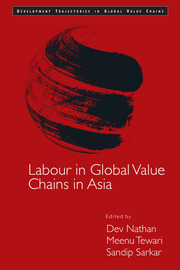Book contents
- Frontmatter
- Contents
- Figures
- Tables
- Foreword
- Preface
- Acknowledgements
- Introduction
- Captive Governance
- 2 Achieving Better Work for Apparel Workers in Asia
- 3 Improving Wages and Working Conditions in the Bangladesh Garment Sector: The Role of Horizontal and Vertical Relations
- 4 Bargaining in Garment GVCs: The Asia Floor Wage
- 5 Fresh Produce Markets, Standards, and Dynamics of Labour: Grapes in India
- 6 The ‘Zero-Fee’ Tour: Price Competition and Chain Downgrading in Chinese Tourism
- 7 Restricting Competition to Reduce Poverty: Impact of the Tourism Value Chain in an Upland Economy in China
- 8 Restructuring of Post-crisis GVCs: Tourism in Bali, Indonesia
- 9 Dynamics of Labour-intensive Clusters in China: Wage Costs and Moving Inland
- 10 Migrant Labour in Global Value Chains in Asia
- Modular Governance
- Relational Governance
- Conclusions
- Notes on Contributors
- Index
8 - Restructuring of Post-crisis GVCs: Tourism in Bali, Indonesia
from Captive Governance
Published online by Cambridge University Press: 23 July 2017
- Frontmatter
- Contents
- Figures
- Tables
- Foreword
- Preface
- Acknowledgements
- Introduction
- Captive Governance
- 2 Achieving Better Work for Apparel Workers in Asia
- 3 Improving Wages and Working Conditions in the Bangladesh Garment Sector: The Role of Horizontal and Vertical Relations
- 4 Bargaining in Garment GVCs: The Asia Floor Wage
- 5 Fresh Produce Markets, Standards, and Dynamics of Labour: Grapes in India
- 6 The ‘Zero-Fee’ Tour: Price Competition and Chain Downgrading in Chinese Tourism
- 7 Restricting Competition to Reduce Poverty: Impact of the Tourism Value Chain in an Upland Economy in China
- 8 Restructuring of Post-crisis GVCs: Tourism in Bali, Indonesia
- 9 Dynamics of Labour-intensive Clusters in China: Wage Costs and Moving Inland
- 10 Migrant Labour in Global Value Chains in Asia
- Modular Governance
- Relational Governance
- Conclusions
- Notes on Contributors
- Index
Summary
Introduction
Global value chains (GVCs) can change in structure, with a key factor in such changes being shocks. Shocks are defined as occurrences that originate from outside the system, or are exogenous to the GVC. Within the tourism GVC, one of the most powerful factors within the GVC is the tourists, the customers themselves. A shock could affect the composition of tourists, and not all segments of the GVC are likely to be affected equally. For instance, the current global economic crisis has clearly impacted developed economies more than emerging economies. This could result in a shift in the composition of tourists away from the developed economies towards the emerging economies. Tour operators (TOs) from the two sets of countries would correspondingly gain or lose power within the GVC, with domestic TOs gaining proportionately more from new business opportunities as a result.
In the current post-crisis situation, there has been some attention given to the restructuring of GVCs. Cattaneo et al. (2011) point to the shifts in end markets and the growing importance of emerging economies and regional value chains. However, it is not just end markets and product standards that could change, but the structure of GVCs as well. Milberg and Winkler (2011) point to the possibilities of both vertical and horizontal consolidation in value chains. Vertical consolidation could take place when markets shrink, thus reducing the extent of the division of labour and leading to some consolidation of tasks within the remaining tiers of the supply chain. There could also be horizontal consolidation, with the number of firms operating in any tier falling on account of the shrinking market. Milberg and Winkler raise an interesting question about whether there would be symmetry in shrinkage and recovery, with the number of firms being restored in recovery. They expect that the high-productivity suppliers might be better able to expand in recovery, so that there would be a consolidation in the GVC. They also put forward the hypothesis that buyer-driven chains would experience more consolidation than supplier-driven chains.
- Type
- Chapter
- Information
- Labour in Global Value Chains in Asia , pp. 154 - 182Publisher: Cambridge University PressPrint publication year: 2016

